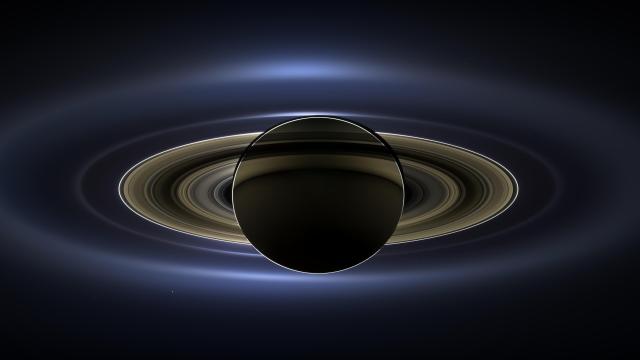Saturn’s rings are one of the most iconic structures in the solar system, but their genesis has long been up for debate. New research suggests that the spectacular rings may have been born out of the death of an icy moon.
Saturn is a dynamic system. Besides those fascinating rings, one if its moons, Titan, is moving rapidly away from the planet at about 4 inches (11 centimeters) per year (our own Moon moves away from Earth at a slow 1.5 inches annually). Saturn is also tilted at an angle of 26.7 degrees from the plane of its orbit, and while that’s not all that uncommon in our solar system, the mechanism that caused this tilt is shrouded in mystery. However, a paper published yesterday in Science may point to the missing link that could connect all these phenomena: anow-extinct icy moon of Saturn called Chrysalis.
“If you throw a top on a table, after an initial wobble period, it settles down into a motion where this spin axis of the top regularly makes a circle around the vertical. That’s the ‘precession’ of the top,” said Jack Wisdom in a phone call with Gizmodo. Wisdom is a professor of planetary science at Massachusetts Institute of Technology and is lead author of the new study. Wisdom said that the precession of Saturn and distant neighbour Neptune were at one point very close, or resonant. This resonance, coupled with Titan’s migration away from Saturn, could have explained why the planet tilted.
But as Wisdom and his colleagues examined gravitational data from the Cassini spacecraft, they noticed that Saturn and Neptune were no longer in resonance and began to wonder what mechanism could have caused this. “We came upon the idea that Saturn used to have another satellite,” said Wisdom. “If that satellite were suddenly lost, then [Saturn] could get out of the resonance.”
They’re calling this hypothetical lost moon Chrysalis and think it existed somewhere between the orbits of the moons Titan and Iapetus. Through computer modelling, they found that as Titan spiraled outward, it would destabilize Chrysalis’ orbit. Chrysalis would then move toward Saturn, where it would be ripped apart by the planet’s gravitational field, creating the rings we see today while pushing Saturn out of Neptune’s resonance. All this drama would have gone down about 100 million years ago.
“It all fits together,” said Wisdom. “Even though it’s a chain of events, each element in the chain is not an improbable thing.”
Henry Throop, a program scientist at NASA’s Planetary Science Division who is unaffiliated with the new paper, was intrigued by the findings. “What is compelling about their hypothesis is that it ties together so many unexplained aspects of Saturn’s current state: the apparently young age of the rings, the steep tilt of Saturn on it axis, and the high eccentricity of Titan’s orbit. If correct, the concept presented here extends our understanding that the solar system is continuing to evolve in significant ways,” Throop wrote in an email to Gizmodo. Throop has worked with the Cassini Data Analysis Program, which funded some of the paper’s research.
Luke Dones, an unaffiliated researcher from the Planetary Science Directorate at the Southwest Research Institute in Boulder, Colorado, said that more research is needed to fully flesh out the existence and lifespan of Chrysalis. “There’s plenty of space between [Iapetus and Titan] where there could have been a satellite, but there’s also no independent evidence that such a moon existed,” said Dones in an email. “Perhaps Saturn’s rings did form in the way they describe, but they haven’t provided a definitive answer. The authors didn’t simulate the formation of the rings, but relied on previous work in their brief discussion at the end of the paper.”
The origin of Saturn’s rings is one of the great mysteries of our little corner of the Milky Way. The untimely demise of Chrysalis, assuming it did exist, could be the reason that Saturn is a favourite target of amateur and professional astronomers alike.
